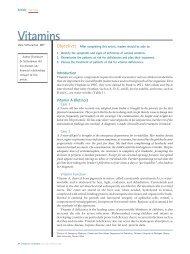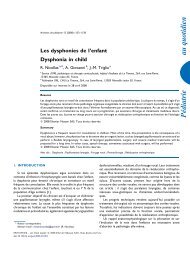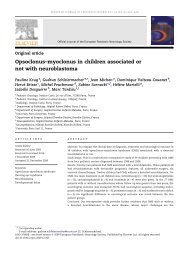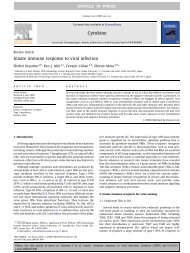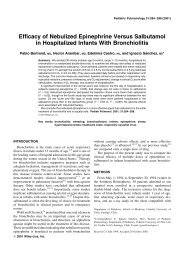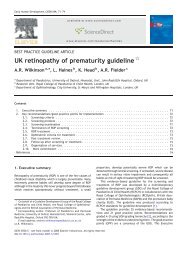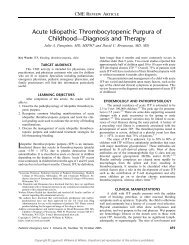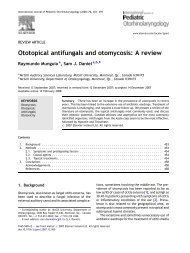Fetal lower urinary tract obstruction - sepeap
Fetal lower urinary tract obstruction - sepeap
Fetal lower urinary tract obstruction - sepeap
You also want an ePaper? Increase the reach of your titles
YUMPU automatically turns print PDFs into web optimized ePapers that Google loves.
Seminars in <strong>Fetal</strong> & Neonatal Medicine (2007) 12, 464e470<br />
available at www.sciencedirect.com<br />
journal homepage: www.elsevier.com/locate/siny<br />
<strong>Fetal</strong> <strong>lower</strong> <strong>urinary</strong> <strong>tract</strong> <strong>obstruction</strong><br />
David Lissauer, Rachel K. Morris, Mark D. Kilby*<br />
Division of Reproductive and Child Health, Birmingham Women’s Hospital,<br />
University of Birmingham, Birmingham, B15 2TG, UK<br />
KEYWORDS<br />
Vesico-amniotic<br />
shunting;<br />
Lower <strong>urinary</strong> <strong>tract</strong><br />
<strong>obstruction</strong>;<br />
Posterior urethral<br />
valves<br />
Summary <strong>Fetal</strong> <strong>lower</strong> <strong>urinary</strong> <strong>tract</strong> <strong>obstruction</strong> affects 2.2 per 10 000 births. It is a consequence<br />
of a range of pathological processes, most commonly posterior urethral valves (64%)<br />
or urethral atresia (39%). It is a condition of high mortality and morbidity associated with progressive<br />
renal dysfunction and oligohydramnios, and hence fetal pulmonary hypoplasia. Accurate<br />
detection is possible via ultrasound, but the underlying pathology is often unknown. In<br />
future, magnetic resonance imaging (MRI) may be increasingly used alongside ultrasound in<br />
the diagnosis and assessment of fetuses with <strong>lower</strong> <strong>urinary</strong> <strong>tract</strong> <strong>obstruction</strong>. <strong>Fetal</strong> urine analysis<br />
may provide improvements in prenatal determination of renal prognosis, but the optimum<br />
criteria to be used remain unclear. It is now possible to decompress the <strong>obstruction</strong> in utero via<br />
percutaneous vesico-amniotic shunting or cystoscopic techniques. In appropriately selected<br />
fetuses intervention may improve perinatal survival, but long-term renal morbidity amongst<br />
survivors remains problematic.<br />
ª 2007 Elsevier Ltd. All rights reserved.<br />
Introduction<br />
<strong>Fetal</strong> <strong>lower</strong> <strong>urinary</strong> <strong>tract</strong> <strong>obstruction</strong> (LUTO) can be a consequence<br />
of a range of pathological processes. The most<br />
common anomaly is posterior urethral valves (PUVs), and<br />
these account for approximately half of cases presenting<br />
with ultrasound features of LUTO. 1 Urethral <strong>obstruction</strong> is<br />
another common cause of urethral atresia. 2 The affected<br />
fetus is typically male; females with LUTO often demonstrate<br />
more complex morbid pathologies such as cloacal<br />
plate anomalies, including megacystis microcolon syndrome<br />
(dysfunctional smooth muscle in bladder and distal bowel).<br />
* Corresponding author. Tel.: þ44 121 627 2778; fax: þ44 121 415<br />
4837.<br />
E-mail address: m.d.kilby@bham.ac.uk (M.D. Kilby).<br />
LUTO is a disease of high mortality and morbidity. It is<br />
associated with cystic renal dysplasia and abnormal renal<br />
(glomerular and tubular) function. Progressive renal dysfunction<br />
may lead to severe oligohydramnios, predisposing<br />
the fetus to pulmonary hypoplasia and positional limb<br />
abnormalities. 3<br />
Animal models have suggested that decompressing the<br />
<strong>obstruction</strong> may modify the pathogenesis, 4,5 and prenatal<br />
in-utero therapy has been considered in ‘selected’ cases<br />
in an attempt to improve survival and attenuate the secondary<br />
developmental complications. Current therapies<br />
include percutaneous vesico-amniotic shunting and inutero<br />
percutaneous cystoscopy. However, prenatal counselling<br />
in this situation is difficult, as the modalities used<br />
to assess fetal renal function have uncertain prognostic<br />
value, and the effectiveness of therapy remains to be<br />
established.<br />
1744-165X/$ - see front matter ª 2007 Elsevier Ltd. All rights reserved.<br />
doi:10.1016/j.siny.2007.06.005
<strong>Fetal</strong> <strong>lower</strong> <strong>urinary</strong> <strong>tract</strong> <strong>obstruction</strong> 465<br />
Incidence<br />
Population-based data from the English ‘Northern Region<br />
Congenital Anomaly Register’ showed that LUTO affects 2.2<br />
per 10 000 births. Between 1984 and 1997, 113 cases were<br />
registered, the underlying pathology being identified by<br />
postnatal investigation or autopsy. PUV was found in 64%<br />
(1.4/10 000 births), urethral atresia in 39% (0.7/10 000<br />
births), ‘prune-belly syndrome’ in 4%, and remained unidentified<br />
in 4%. 6<br />
Natural history and pathophysiology<br />
Several studies of the natural history of LUTO have been<br />
performed, and they consistently demonstrate high mortality<br />
rates and poor renal outcomes (Table 1). The studies<br />
have identified that the high mortality is predominantly due<br />
to pulmonary hypoplasia associated with severe oligohydramnios<br />
mid-trimester. 7 In the series reported by Mahoney<br />
et al., when oligohydramnios was present the mortality<br />
rate was as high as 80%, and surviving fetuses had significant<br />
renal morbidity, with 25e30% developing end-stage<br />
chronic renal impairment necessitating dialysis or transplantation.<br />
8 This accounts for 60% of all paediatric renal<br />
transplants. 9<br />
As well as the degree of oligohydramnios, poor outcome<br />
is also predicted by earlier presentation 10 and the finding of<br />
associated structural and/or chromosomal abnormalities.<br />
Animal models have helped further our understanding of<br />
these associations. Harrison’s group utilized a fetal lamb<br />
model in which they induced complete urethral <strong>obstruction</strong><br />
at 95e105 days. This resulted in severe hydronephrosis,<br />
hydroureter, megacystis, <strong>urinary</strong> ascites, and significant<br />
pulmonary hypoplasia. Decompression in utero resulted in<br />
some resolution of the <strong>urinary</strong> <strong>tract</strong> dilatation. However,<br />
the expected cystic and dysplastic renal changes central<br />
to the pathophysiology in humans were not demonstrated<br />
in this model. 4,5 The failure to demonstrate a causative relationship<br />
between <strong>obstruction</strong> and cystic renal dysplasia<br />
led to subsequent experiments in which unilateral urethral<br />
<strong>obstruction</strong> was introduced at 60 days in fetal lambs. These<br />
demonstrated renal dysplastic changes on the obstructed<br />
side, the severity of which correlated with the length of<br />
time of <strong>obstruction</strong>. 11<br />
The applicability of these animal models to humans<br />
remains controversial. Experimentally, the <strong>obstruction</strong> is<br />
not introduced from the commencement of renal development,<br />
and most congenital <strong>obstruction</strong> is partial, not<br />
complete. It has also proved difficult to reproduce the<br />
histological changes of renal dysplasia seen in humans, so it<br />
remains possible that <strong>obstruction</strong> may not be the sole cause<br />
of the renal dysplasia seen in bladder outlet <strong>obstruction</strong>. 12<br />
Diagnosis and assessment<br />
Ultrasound<br />
Ultrasound can accurately detect fetal <strong>lower</strong> <strong>urinary</strong> <strong>tract</strong><br />
<strong>obstruction</strong> 13,14 with a sensitivity of 95% and a specificity of<br />
80%. 13 The sensitivity of ultrasound screening for these abnormalities<br />
is improved because anomalies of the renal <strong>tract</strong><br />
and kidneys are also associated with secondary findings,<br />
such as oligohydramnios.<br />
Assessment of the fetal genito<strong>urinary</strong> <strong>tract</strong> is a part of<br />
all routine ultrasound examinations. When abnormalities<br />
are detected, this should lead to a detailed assessment<br />
focusing on amniotic fluid volume, renal size and parenchyma,<br />
the collecting system, and bladder size. 15 Dilatation<br />
of the renal pelvis and fluid-filled areas as small as 1e2 mm<br />
may be visualized in utero using high-resolution real-time<br />
ultrasound. 16<br />
Ultrasonography may allow differentiation of obstructive<br />
and non-obstructive causes of megacystis, with the<br />
association of increased echogenicity and oligohydramnios<br />
in the presence of bladder distension being predictive of an<br />
obstructive aetiology. Similarly, in cases of hydronephrosis,<br />
Oliveira et al. showed that oligohydramnios and megacystis<br />
were predictive of an obstructive aetiology, with the<br />
sensitivity and specificity of the combination of both variables<br />
being 60 and 98% respectively. 17 However, ultrasound<br />
is of limited value in determinng the underlying aetiology<br />
causing the LUTO. 13<br />
Table 1<br />
Reference<br />
Summary of studies showing the natural history of <strong>lower</strong> <strong>urinary</strong> <strong>tract</strong> <strong>obstruction</strong> a<br />
Number<br />
of cases<br />
Mortality (%)<br />
Cystic renal<br />
disease/chronic<br />
renal failure in<br />
Anumba study (%)<br />
Pulmonary<br />
hypoplasia (%)<br />
Thomas et al., 1985 46 18 33 56 30 56<br />
Mahoney et al., 1985 47 40 63 45 40 e<br />
Nakayama et al., 1986 48 11 45 37 48 e<br />
Hayden et al., 1988 49 14 64 e 36 43<br />
Reuss et al., 1988 50 43 72 36 10 42<br />
Anumba et al., 2005 6 113 75 (prenatal detection,<br />
includes TOP);<br />
53 (postnatal detection)<br />
67 (detection<br />
before 24 weeks);<br />
40 (detection<br />
after 24 weeks)<br />
26 (without<br />
shunting);<br />
25 (with<br />
shunting)<br />
Total/mean values 239 58 47 31 41<br />
a Reproduced from Studd et al. 51 with permission.<br />
Associated<br />
structural or<br />
chromosomal<br />
anomalies (%)<br />
23
466 D. Lissauer et al.<br />
An important prognostic feature on ultrasound diagnosis<br />
is the presence of significant oligohydramnios, which if<br />
present prior to 24 weeks is associated with a higher prevalence<br />
of pulmonary hypoplasia and eventual renal dysplasia<br />
and impairment. 18 However, this is only predictive if the<br />
liquor volume is reduced chronically.<br />
In addition, the presence of macro/microcystic change<br />
within the renal parenchyma on ultrasound examination is<br />
associated with a high rate of histologically demonstrable<br />
renal dysplasia and severe renal impairment at birth. 19<br />
However, the inability to detect renal cysts on ultrasound<br />
does not predict that dysplastic renal disease is not present.<br />
Magnetic resonance imaging (MRI)<br />
The advent of single-shot fast-spin echo (SSFSE) techniques<br />
has enable MRI to be used in prenatal diagnosis, including<br />
assessment of the <strong>urinary</strong> system. 20 Cassart et al. in 2004<br />
found that in 16 third-trimester fetuses with suspected <strong>urinary</strong>-<strong>tract</strong><br />
abnormalities following ultrasound, the addition<br />
of MRI examination modified the diagnosis in five cases. 21<br />
MRI is reported as being of particular benefit when used<br />
in addition to ultrasonography of the fetal <strong>urinary</strong> <strong>tract</strong> if<br />
the resolution of ultrasound is impaired by oligohydramnios.<br />
22 Amnioinfusion is useful in these situations to aid<br />
visualization with ultrasound, but results are more limited<br />
towards term. 23 However, amnioinfusion is an invasive procedure<br />
which may result in complications such as premature<br />
rupture of membranes, amnionitis, fetal heart rate<br />
abnormalities, or even embolisms, whereas MRI is a lessinvasive<br />
alternative. 24<br />
In future MRI is likely to be used increasingly alongside<br />
ultrasound in the diagnosis of LUTO.<br />
In-utero percutaneous cystoscopy<br />
Difficulties establishing the cause of obstructive uropathy<br />
with ultrasound have led to a search for alternative<br />
techniques. Percutaneous fetal cystoscopy is being utilized<br />
as a means of allowing better diagnosis of the cause of the<br />
<strong>obstruction</strong>, to enhance prognostication, and to allow the<br />
application of novel therapeutic techniques. Two groups<br />
have demonstrated the feasibility of this technique, enabling<br />
visualization of the ureteral orifices, bladder neck<br />
and urethra, as well as instrumentation of the urethra. 1,25<br />
It can improve diagnostic accuracy when combined with ultrasound,<br />
and the extension of its use to provide alternative<br />
therapeutic approaches will be discussed later. 25<br />
Antenatal assessment<br />
It is mandatory to perform a detailed anomaly scan,<br />
determine fetal sex, and offer fetal karyotyping (due to<br />
the high incidence of karyotypic abnormalities) in cases of<br />
obstructive uropathy. Allocation of fetal gender may allow<br />
diagnosis to be further elucidated. Posterior urethral valves<br />
and urethral atresia have a very high prevalence in male<br />
fetuses. In the presence of severe oligohydramnios, amnioinfusion<br />
may occasionally be required to allow accurate<br />
evaluation of fetal structures. If a normal karyotype is<br />
confirmed in a fetus with LUTO, and no other congenital<br />
anomalies are present, consideration of in-utero treatment<br />
may be justified. Other prognostic indicators such as the<br />
appearance of the kidneys and liquor volume are evaluated.<br />
Renal function may need to be assessed to ensure that any<br />
intervention will benefit the fetus. Several methods have<br />
been utilized, including fetal urine, serum or amniotic fluid<br />
analysis, and finally renal biopsy.<br />
It is important to differentiate true urethral <strong>obstruction</strong><br />
from the megacystis-mega-ureter-microcolon syndrome<br />
(MMIHS), a rare disorder characterized by a functional<br />
intestinal <strong>obstruction</strong>/hypomobility and enlarged nonobstructed<br />
bladder. It is more common in females, and has<br />
a very poor prognosis. As it can be difficult to differentiate<br />
on ultrasound, it is important to consider this diagnosis<br />
carefully in a female with LUTO but normal liquor volume. In<br />
general, it is not beneficial to consider in-utero shunting for<br />
these pregnancies.<br />
Assessment of fetal renal function<br />
<strong>Fetal</strong> urine<br />
Assessment of fetal renal function may be helpful prognostically<br />
and can be performed by fetal <strong>urinary</strong> analysis.<br />
There are many studies examining the relationship between<br />
a range of fetal <strong>urinary</strong> metabolites and subsequent<br />
renal function, but most are of small size and utilize<br />
different ‘normal’ ranges, making direct comparison difficult.<br />
No consensus has yet been reached on the optimum<br />
approach.<br />
Urinary sodium can be used as an index of renal<br />
tubular function, with values 100 mmol/L have<br />
been shown to be highly predictive of fetal or perinatal<br />
death from terminal renal or pulmonary failure. 26,27 The<br />
b2-Microglobulin has also been used as an index of fetal<br />
glomerular filtration rate (GFR) and in the prediction of<br />
postnatal GFR. b 2 -Microglobulin is a low-molecular-weight<br />
protein that is freely filtered by the fetal glomeruli;<br />
>99.9% is reabsorbed and metabolized in the proximal tubules<br />
in a normally functioning kidney. However, in renal<br />
disease it is postulated that damage to the tubules results<br />
in the excretion of b 2 -microglobulin in the urine. 28,29<br />
A b 2 -microglobulin >13 mg/L has been reported to be invariably<br />
fatal, 30 and a value of >6 has been suggested as<br />
poor prognostic factor when evaluating the benefits of<br />
intervention. 31<br />
Sequential urine analysis allows assessment of ‘fresh’<br />
urine and renal reserve, and has been shown to improve<br />
prognostic accuracy. In cases of severe renal damage, the<br />
expected decrease in hypertonicity with repeated samples<br />
is not observed. Conversely, some fetuses may be identified<br />
where, despite initially high absolute values, their electrolytes<br />
improve on sequential samples, and this may indicate<br />
a salvageable kidney. 26,27<br />
<strong>Fetal</strong> serum and fetal renal biopsy<br />
<strong>Fetal</strong> serum monitoring has been utilized to assess fetal<br />
renal function. Serum creatinine cannot be used, as creatinine<br />
crosses the placenta and is filtered by the mother.<br />
However, serum microglobulins such as a 1- microglobulin,<br />
retinol binding protein, and b 2 -microglobulin, due to their<br />
molecular weight, cannot cross the placenta but are still
<strong>Fetal</strong> <strong>lower</strong> <strong>urinary</strong> <strong>tract</strong> <strong>obstruction</strong> 467<br />
filtered by the fetal glomerulus. They have been suggested<br />
as potential measures of fetal renal function. 32 Serum monitoring<br />
can be used even after the placement of a shunt if<br />
there is insufficient urine for urine sampling, but its measurement<br />
is associated with the risks of cordocentesis.<br />
<strong>Fetal</strong> renal biopsy is possible by ultrasound-guided fineneedle<br />
aspiration, but is rarely performed as it has a low<br />
success rate in obtaining fetal tissue. 33<br />
Therapeutic options<br />
Animal models suggesting that potentially reversing the<br />
<strong>obstruction</strong> in LUTO may optimize renal function, maximize<br />
amniotic fluid volume and prevent pulmonary hypoplasia, 4<br />
have paved the way for interventions attempting to decompress<br />
human fetal <strong>urinary</strong> <strong>tract</strong> <strong>obstruction</strong> and thus improve<br />
prognosis and survival.<br />
Open fetal surgery<br />
The initial approach adopted involved open hysterotomy.<br />
Harrison et al. performed the first successful in-utero<br />
decompression for hydronephrosis in 1981. 34 The maternal<br />
morbidity associated with open surgery, and associated fetal<br />
risks of preterm labour and neurological sequelae, have<br />
led to the development of alternative minimally invasive<br />
techniques. 35,36 No new cases of open fetal surgery have<br />
been reported since 1988. 37<br />
Vesico-amniotic shunting<br />
Ultrasound-guided percutaneous vesico-amniotic shunting<br />
is the most commonly used method to relieve <strong>urinary</strong> <strong>tract</strong><br />
<strong>obstruction</strong>. This technique involves the placement of<br />
a double pig-tailed catheter under ultrasound guidance<br />
and local anaesthesia, with the distal end in the fetal<br />
bladder and the proximal end in the amniotic cavity to<br />
allow drainage of fetal urine (Fig. 1).<br />
Amnioinfusion is often recommended prior to shunt<br />
insertion in cases of severe oligohydramnios to allow space<br />
for insertion. The use of colour doppler allows the umbilical<br />
arteries to be delineated as they course round the fetal<br />
bladder.<br />
In 1986, the International <strong>Fetal</strong> Surgery Register<br />
audited 73 fetuses with ultrasound evidence of LUTO<br />
that had been treated with vesico-amniotic shunts. 38<br />
Overall survival rates of 41% were demonstrated. It was<br />
suggested that better patient selection through further<br />
prognostic testing prior to intervention could further improve<br />
survival rates.<br />
In 1997 Coplen reviewed 169 cases of successful<br />
percutaneous shunt placements over 14 years. 39 Overall<br />
survival was found to be 47%, with 40% of survivors having<br />
end-stage renal disease. Coplen concluded that limiting intervention<br />
to fetuses with good prognosis would improve<br />
survival and result in a <strong>lower</strong> incidence of renal failure<br />
in survivors. Notably, shunt-related complications were<br />
common, occurring in 45% of cases, which may necessitate<br />
further shunts being placed. These included shunt blockage<br />
(25%), shunt migration (20%), preterm labour and miscarriage,<br />
amniorrhexis, chorioamnionitis, and iatrogenic<br />
gastroschisis. <strong>Fetal</strong> extremities becoming entangled in<br />
the intra-amniotic portion of the shunt may cause physical<br />
displacement of the shunt from the fetal bladder. Following<br />
displacement, urine may flow through the defect in the<br />
bladder to cause <strong>urinary</strong> ascites. This can result in massive<br />
fetal abdominal distension with serious sequelae, and may<br />
require further abdominal shunts until the bladder defect<br />
has healed.<br />
Figure 1 Technique for placing the Harrison double-pig-tailed catheter under sonographic guidance. Reproduced from Harrison<br />
et al. 52 with permission.
468 D. Lissauer et al.<br />
<strong>Fetal</strong> cystoscopy<br />
This technique offers opportunities for cystoscopic therapies<br />
to be delivered. It was first described under maternal<br />
general anaesthesia, 40 but has now been performed under<br />
local anaesthesia. 41 Therapeutic options include mechanical<br />
or laser endoscopic ablation of posterior urethral valves<br />
and the positioning of urethral vesico-amniotic shunts. In<br />
2003 Welsh et al. reported the successful treatment of<br />
6/10 fetuses by hydroablation or guide-wire passage; five<br />
of these fetuses survived. 25 It has been postulated that direct<br />
valve ablation may be advantageous in that it allows<br />
restoration of normal fetal bladder dynamics. 42 This may<br />
be beneficial, as there are concerns that the fetal <strong>urinary</strong><br />
diversion from stenting, with the resulting chronic bladder<br />
decompression, may cause aberrant detrusor con<strong>tract</strong>ions<br />
and voiding dysfunction in children with PUV. 43<br />
Systematic review and meta-analysis of<br />
prenatal bladder drainage<br />
In 2003 Clark et al. conducted a systematic review and<br />
meta-analysis to estimate the effect of prenatal bladder<br />
drainage on perinatal survival in fetuses with LUTO. 44<br />
Vesicocentesis, vesico-amniotic shunting, and open fetal<br />
bladder surgery were included. The review identified 16<br />
observational studies that included nine case series (147<br />
fetuses) and seven controlled series (197 fetuses). The review<br />
demonstrated that, despite this form of fetal therapy<br />
having been practised for more than 25 years, there is<br />
a lack of high-quality evidence to reliably inform clinical<br />
practice. There were no randomized controlled trials,<br />
many studies were observational series without control<br />
data, and the methodological quality was deemed to be<br />
relatively poor. Meta-analysis showed that in-utero vesico-amniotic<br />
drainage appeared to improve overall perinatal<br />
survival as compared to the non-drainage group (OR<br />
2.5; 95% CI 1.0e5.9; P < 0.03). However, subgroup analysis<br />
indicated that this improved survival was predominantly<br />
noted in fetuses with a defined ‘poor prognosis’ (defined<br />
on ultrasound appearance and/or fetal urinalysis) where<br />
there appeared to be marked improvement (OR 8.0; 95%<br />
CI, 1.2e52.9; P < 0.03). The findings of the meta-analysis<br />
must be interpreted with caution, as the uncontrolled observational<br />
studies from which the analysis was drawn may<br />
be liable to selection bias and could overestimate the<br />
effect of the therapy. The review could also not comment<br />
on the timing and indications for intervention. Further<br />
research in the form of a randomized controlled trial is required<br />
to assess the short- and long-term effects of this<br />
intervention.<br />
Long-term outcome<br />
Long-term follow up of 19 boys with PUV in whom no<br />
intrauterine intervention was carried out showed that 32%<br />
were uraemic, 21% had moderate renal failure, and 48% had<br />
not been checked since adolescence. In 40% there were<br />
signs of bladder dysfunction; however, all were continent.<br />
Fertility was compromised in those who were uraemic. 45<br />
Biard et al. recently reported their experience of longterm<br />
clinical outcomes in 20 male fetuses with oligohydramnios<br />
and LUTO who were treated prenatally; 31 45% had<br />
acceptable renal function, 22% had mild renal impairment,<br />
and 33% had end-stage renal failure requiring transplantation.<br />
Growth and developmental abnormalities were common,<br />
with 50% having growth below the 25th centile, and<br />
50% of the children also reported ongoing respiratory problems<br />
or musculoskeletal abnormalities. Positive findings<br />
were that good cognitive development was seen. With appropriate<br />
medical and surgical care, a majority achieved<br />
acceptable social continence, and quality-of-life measures<br />
were not significantly different from those in a healthy<br />
population.<br />
While intervention may apparently reduce perinatal<br />
mortality, the improvement of long-term renal sequelae<br />
remains problematic.<br />
The percutaneous shunting in <strong>lower</strong> <strong>urinary</strong><br />
<strong>tract</strong> <strong>obstruction</strong> trial (PLUTO)<br />
The systematic examination of the literature by Clarke<br />
et al. 44 described above confirmed the scarcity of highquality<br />
evidence to inform decision-making around vesicoamniotic<br />
shunting. A randomized controlled trial which<br />
hopes to answer the dilemma surrounding the role of vesico-amniotic<br />
shunting in moderate to severe LUTO is now<br />
in progress. The PLUTO (Percutaneous Shunting in Lower<br />
Urinary Tract Obstruction) trial funded by Wellbeing for<br />
Women is a multicentre trial within the UK, and will hopefully<br />
be extended later to Europe. It is hoped that over a 5-<br />
year period 200 women will be recruited. Recruitment is<br />
based on a pragmatic approach. Rather than rigid entry criteria,<br />
recruitment is based on the ‘uncertainty principle’.<br />
That is, as long as the fetus is male with evidence of<br />
LUTO without other abnormalities, and the clinical team<br />
is substantially uncertain which treatment (shunt versus<br />
no shunt) should be offered for the fetus at the current<br />
time, that fetus is eligible to be randomized. The trial<br />
also contains a prospective registry for those who fit the entry<br />
criteria but the fetal medicine specialist is not uncertain<br />
or the mother does not wish to be randomized. Further information<br />
can be obtained at www.pluto.bham.ac.uk.<br />
Conclusion<br />
Lower <strong>urinary</strong> <strong>tract</strong> <strong>obstruction</strong> is a heterogeneous condition<br />
associated with a high mortality and morbidity.<br />
Ultrasound offers accurate diagnosis of <strong>obstruction</strong>, but<br />
the underlying aetiology often remains unknown until after<br />
birth. <strong>Fetal</strong> urine analysis may improve the prenatal<br />
determination of renal prognosis, but the optimum criteria<br />
to be used remain unclear. It is now possible in utero to<br />
decompress the <strong>obstruction</strong> via percutaneous vesicoamniotic<br />
shunting or cystoscopic techniques. In appropriately<br />
selected fetuses intervention may improve perinatal<br />
survival, but long-term renal morbidity amongst survivors<br />
remains problematic. It is hoped that the PLUTO trial will<br />
help clarify the uncertainty which remains regarding the<br />
efficacy of percutaneous shunting.
<strong>Fetal</strong> <strong>lower</strong> <strong>urinary</strong> <strong>tract</strong> <strong>obstruction</strong> 469<br />
Practice points<br />
Lower <strong>urinary</strong> <strong>tract</strong> <strong>obstruction</strong> (LUTO) is a disease<br />
of high mortality and morbidity.<br />
Diagnosis may be made at second-trimester<br />
ultrasound.<br />
Prognosis is related to amniotic fluid volume,<br />
presence of renal cysts, and other congenital or<br />
structural anomalies.<br />
Intervention is available in the form of vesicoamniotic<br />
shunting, but the efficacy of this is not<br />
proven.<br />
Research directions<br />
The efficacy and long-term safety of vesicoamniotic<br />
shunting (PLUTO trial).<br />
The predictive accuracy of fetal urinalysis.<br />
References<br />
1. Quintero RA, Johnson MP, Romero R, et al. In-utero percutaneous<br />
cystoscopy in the management of fetal <strong>lower</strong> obstructive<br />
uropathy. Lancet 1995;346(8974):537e40.<br />
2. Steinhardt G, Hogan W, Wood E, Weber T, Lynch R. Long-term survival<br />
in an infant with urethral atresia. J Urol 1990;143:336e7.<br />
3. Merrill DC, Weiner CP. Urinary <strong>tract</strong> <strong>obstruction</strong>. In: Fisk NM,<br />
Moise Jr KJ, editors. <strong>Fetal</strong> therapy: invasive and transplacental.<br />
Cambridge: Cambridge University Press; 1997. p. 273e86.<br />
*4. Harrison MR, Ross NA, Noall RA. Correction of congenital hydronephrosis<br />
in utero I: the model: fetal urethral <strong>obstruction</strong><br />
produces hydronephrosis and pulmonary hypoplasia in fetal<br />
lambs. J Pediatr Surg 1983;18:247e56.<br />
*5. Harrison MR, Nakayama DK, Noall RA, et al. Correction of congenital<br />
hydronephrosis in utero. II: decompression reverses<br />
the effects of <strong>obstruction</strong> on the fetal lung and <strong>urinary</strong> <strong>tract</strong>.<br />
J Pediatr Surg 1982;17:965e74.<br />
*6. Anumba DO, Scott JE, Plant ND, Robson SC. Diagnosis and outcome<br />
of fetal <strong>lower</strong> <strong>urinary</strong> <strong>tract</strong> <strong>obstruction</strong> in the northern<br />
region of England. Prenat Diagn 2005;25(1):7e13.<br />
7. Freedman AL, Johnson MP, Gonzalez R. <strong>Fetal</strong> therapy for obstructive<br />
uropathy: past, present, future? Pediatr Nephrol<br />
2000;14(2):167e76.<br />
8. Parkhouse HF, Barratt TM, Dillon MJ, et al. Long term outcome<br />
of boys with posterior urethral valves. Br J Urol<br />
1988;62:59e62.<br />
9. Parkhouse HF, Woodhouse CR. Long-term status of patients with<br />
posterior urethral valves. Urol Clin North Am 1990;17:373e8.<br />
10. Hutton KA, Thomas DF, Arthur RJ, Irving HC, Smith SE. Prenatally<br />
detected posterior urethral valves: is gestational age at<br />
detection a predictor of outcome? J Urol 1994;152(2 Pt 2):<br />
698e701.<br />
11. Glick PL, Harrison MR, Adzick NS. Correction of congenital<br />
hydronephrosis in utero IV: in utero decompression prevents<br />
renal dysplasia. J Pediatr Surg 1984;19(6):649e57.<br />
12. Berman DJ, Maizels M. The role of <strong>urinary</strong> <strong>obstruction</strong> in the<br />
genesis of renal dysplasia. A model in the chick embryo.<br />
J Urol1982;128(5):1091e1096.<br />
*13. Robyr R, Benachi A, ikha-Dahmane F, Martinovich J, Dumez Y,<br />
Ville Y. Correlation between ultrasound and anatomical<br />
findings in fetuses with <strong>lower</strong> <strong>urinary</strong> <strong>tract</strong> <strong>obstruction</strong> in the<br />
first half of pregnancy. Ultrasound Obstet Gynecol 2005;<br />
25(5):478e82.<br />
14. Kaefer M, Peters CA, Retik AB, Benacerraf BB. Increased renal<br />
echogenicity: a sonographic sign for differentiating between<br />
obstructive and nonobstructive etiologies of in utero bladder<br />
distension. J Urol 1997;158(3 Pt 2):1026e9.<br />
15. Ultrasound screening for fetal abnormalities. Report of the<br />
RCOG working party. London: RCOG; 2000.<br />
16. Arger PH, Coleman BG, Mintz MC, et al. Routine fetal genito<strong>urinary</strong><br />
<strong>tract</strong> screening. Radiology 1985;156:485e9.<br />
*17. Oliveira EA, Diniz JS, Cabral AC, et al. Predictive factors of fetal<br />
urethral <strong>obstruction</strong>: a multivariate analysis. <strong>Fetal</strong> Diagn<br />
Ther 2000;15(3):180e6.<br />
*18. Crombleholme TM, Harrison MR. Golbus et al. <strong>Fetal</strong> intervention<br />
in obstructive uropathy: prognostic indicators and efficacy<br />
of intervention. Am J Obstet Gynecol 1990;162(5):<br />
1239e44.<br />
19. Mahoney BS, Filly RA, Callen PW, Hricak H, Globus MS,<br />
Harrison MR. <strong>Fetal</strong> rennin dysplasia: sonographic evaluation.<br />
Radiology 1984;152:143e6.<br />
20. Hormann M, Brugger PC, Balassy C, Witzani L, Prayer D. <strong>Fetal</strong><br />
MRI of the <strong>urinary</strong> system. Eur J Radiol 2006;57(2):303e11.<br />
21. Cassart M, Massez A, Metens T, et al. Complementary role of<br />
MRI after sonography in assessing bilateral <strong>urinary</strong> <strong>tract</strong> anomalies<br />
in the fetus. Am J Roentgenol 2004;182(3):689e95.<br />
22. Poutamo J, Vanninen R, Partanen K, Kirkinen P. Diagnosing<br />
fetal <strong>urinary</strong> <strong>tract</strong> abnormalities: benefits of MRI compared<br />
to ultrasonography. Acta Obstet Gynecol Scand 2000;79(1):<br />
65e71.<br />
23. Ouzonian J, Paul R., Clinical role of amnio-infusion. Baillieres<br />
Clin Obstet Gynaecol 196;10:259e272.<br />
24. Wenstrom K, Andrews W, Mahler J. Prevalence protocol and<br />
complications associated with amnioinfusion. Am J Obstet<br />
Gynecol 1994;170:341.<br />
25. Welsh A, Agarwal S, Kumar S, Smith RP, Fisk NM. <strong>Fetal</strong> cystoscopy<br />
in the management of fetal obstructive uropathy: experience<br />
in a single European centre. Prenat Diagn 2003 Dec;<br />
23(13):1033e41.<br />
26. Nicolini U, Tannirandorn Y, Vaughan J, Fisk NM, Nicolaidis P,<br />
Rodeck CH. Further predictors of renal dysplasia in fetal obstructive<br />
uropathy: bladder pressure and biochemistry of<br />
’fresh’ urine. Prenat Diagn 1991;11(3):159e66.<br />
*27. Johnson MP, Corsi P, Bradfield W, et al. Sequential urinalysis<br />
improves evaluation of fetal renal function in obstructive uropathy.<br />
Am J Obstet Gynecol 1995;173(1):59e65.<br />
28. Bussieres L, Laborde K, Souberbielle JC, Muller F,<br />
Dommergues M, Sachs C. <strong>Fetal</strong> <strong>urinary</strong> insulin-like growth factor<br />
I and binding protein 3 in bilateral obstructive uropathies.<br />
Prenat Diagn 1995;15(11):1047e55.<br />
29. Eugene M, Muller F, Dommergues M, Le ML, Dumez Y. Evaluation<br />
of postnatal renal function in fetuses with bilateral obstructive<br />
uropathies by proton nuclear magnetic resonance<br />
spectroscopy. Am J Obstet Gynecol 1994;170(2):595e602.<br />
30. Muller F, Bernard M-A, Benkirane A, et al. <strong>Fetal</strong> urine cystatin<br />
C as a predictor of postnatal renal function in bilateral uropathies.<br />
Clin Chem 1999;45(12):2292e3.<br />
*31. Biard JM, Johnson MP, Carr MC, et al. Long-term outcomes in<br />
children treated by prenatal esicoamniotic shunting for <strong>lower</strong><br />
<strong>urinary</strong> <strong>tract</strong> <strong>obstruction</strong>. Obstet Gynecol 2005;106:503e8.<br />
32. Ciardelli V, Rizzo N, Farina A, Vitarelli M, Boni P, Bovicelli L.<br />
Prenatal evaluation of fetal renal function based on serum<br />
beta(2)-microglobulin assessment. Prenat Diagn 2001;21(7):<br />
586e8.<br />
33. Bunduki V, Saldanha LB, Sadek L, Miguelez J, Miyadahira S,<br />
Zugaib M. <strong>Fetal</strong> renal biopsies in obstructive uropathy: feasibility<br />
and clinical correlationsepreliminary results. Prenat<br />
Diagn 1998 Feb;18(2):101e9.
470 D. Lissauer et al.<br />
34. Harrison MR, Golbus MS, Filly RA, et al. <strong>Fetal</strong> surgery for congenital<br />
hydronephrosis. N Engl J Med1982; 306(10): 591e593.<br />
35. Wilson RD, Johnson MP, Flake AW, et al. Reproductive outcomes<br />
after pregnancy complicated by maternal-fetal surgery.<br />
Am J Obstet Gynecol 2004;191(4):1430e6.<br />
36. Bealer JF, Raisanen J, Skarsgard ED, et al. The incidence and<br />
spectrum of neurological injury after open fetal surgery. J Pediatr<br />
Surg 1995;30(8):1150e4.<br />
37. Quintero RA, Morales WJ, Allen MH, Bornick PW, Johnson P.<br />
<strong>Fetal</strong> hydrolaparoscopy and endoscopic cystotomy in complicated<br />
cases of <strong>lower</strong> <strong>urinary</strong> <strong>tract</strong> <strong>obstruction</strong>. Am J Obstet<br />
Gynecol 2000;183(2):324e30.<br />
38. Manning FA, Harrison MR, Rodeck C. Catheter shunts for fetal<br />
hydronephrosis and hydrocephalus. Report of the International<br />
<strong>Fetal</strong> Surgery Registry. N Engl J Med 1986;315(5):336e40.<br />
39. Coplen DE. Prenatal intervention for hydronephrosis. J Urol<br />
1997;157(6):2270e7.<br />
40. Quintero RA, Johnson MP, Munoz H, et al. In utero endoscopic<br />
treatment of posterior urethral valves: preliminary experience.<br />
Prenat Neonat Med 1998;3:208e16.<br />
41. Agarwal SK, Fisk N, Welsh A. Endoscopic management of fetal<br />
obstructive uropathy. J Urol 1999;161:108.<br />
*42. Quintero R, Shukla AR, Homsy YL, Bukkapatnam R. Successful<br />
in utero endoscopic ablation of posterior urethral valves:<br />
a new dimension in fetal urology. Urology 2000;55: 774<br />
(xiiiexv).<br />
43. Shamada K, Hosokawa S, Tohda A, Matsumoto F, Suzuki M,<br />
Morimoto Y. Follow-up of children after fetal treatment for<br />
obstructive uropathy. Int J Urol 1998;5:312e6.<br />
*44. Clark TJ, Martin WL, Divakaran TG, Whittle MJ, Kilby MD,<br />
Khan KS. Prenatal bladder drainage in the management of<br />
fetal <strong>lower</strong> <strong>urinary</strong> <strong>tract</strong> <strong>obstruction</strong>: a systematic review<br />
and meta-analysis. Obstet Gynecol 2003;102(2):367e82.<br />
45. Holmdahl G, Sillen U. Boys with posterior urethral valves: outcome<br />
concerning renal function, bladder function and paternity<br />
at ages 31 to 44 years. J Urol 2005;174(3):1031e4.<br />
46. Thomas DF, Irving HC, Arthur RJ. Pre-natal diagnosis: how useful<br />
is it? Br J Urol 1985;57:784e7.<br />
47. Mahoney BS, Callen PW, Filly RA. <strong>Fetal</strong> urethral <strong>obstruction</strong>:<br />
US evaluation. Radiology 1985;157:221e4.<br />
48. Nakayama DK, Harrison MR, de Lorimier AA. Prognosis of posterior<br />
urethral valves presenting at birth. J Pediatr Surg 1986;<br />
21:43e5.<br />
49. Hayden SA, Russ PD, Pretouris DH. Posterior urethral <strong>obstruction</strong>:<br />
prenatal sonographic findings and clinical outcome in 14<br />
cases. J Ultrasound Med 1988;7:371.<br />
50. Reuss A, Stewart PA, Wladimiroff JW. Non-invasive management<br />
of fetal obstructive uropathy. Lancet 1988;332(8617):<br />
949e51.<br />
51. Morris R, Khan K, Kilby M. Congenital <strong>urinary</strong> <strong>tract</strong> <strong>obstruction</strong><br />
and the efficacy of vesico-amniotic shunting. In: Studd, et al.,<br />
editors. Progress in Obstetrics and Gynaecology. 17th ed.<br />
London: Elsevier; 2006. p. 78e97.<br />
52. Harrison MR, Golbus MS, Filly RA. The unborn patient: prenatal<br />
diagnosis and treatment. 2nd ed. Philadelphia, PA: WB Saunders;<br />
1990. p. 377 [chapter 31].<br />
* Key references are annotated with an asterisk.





